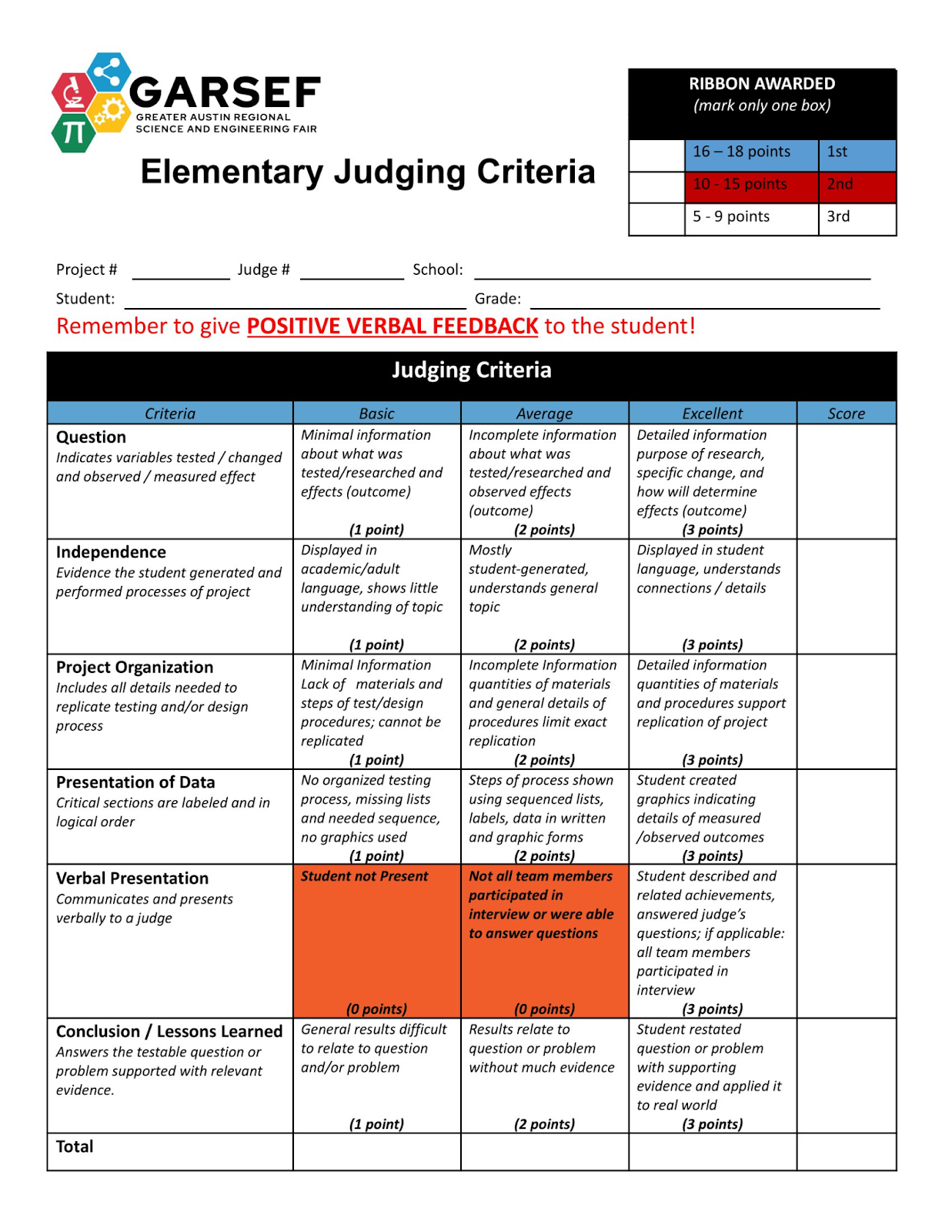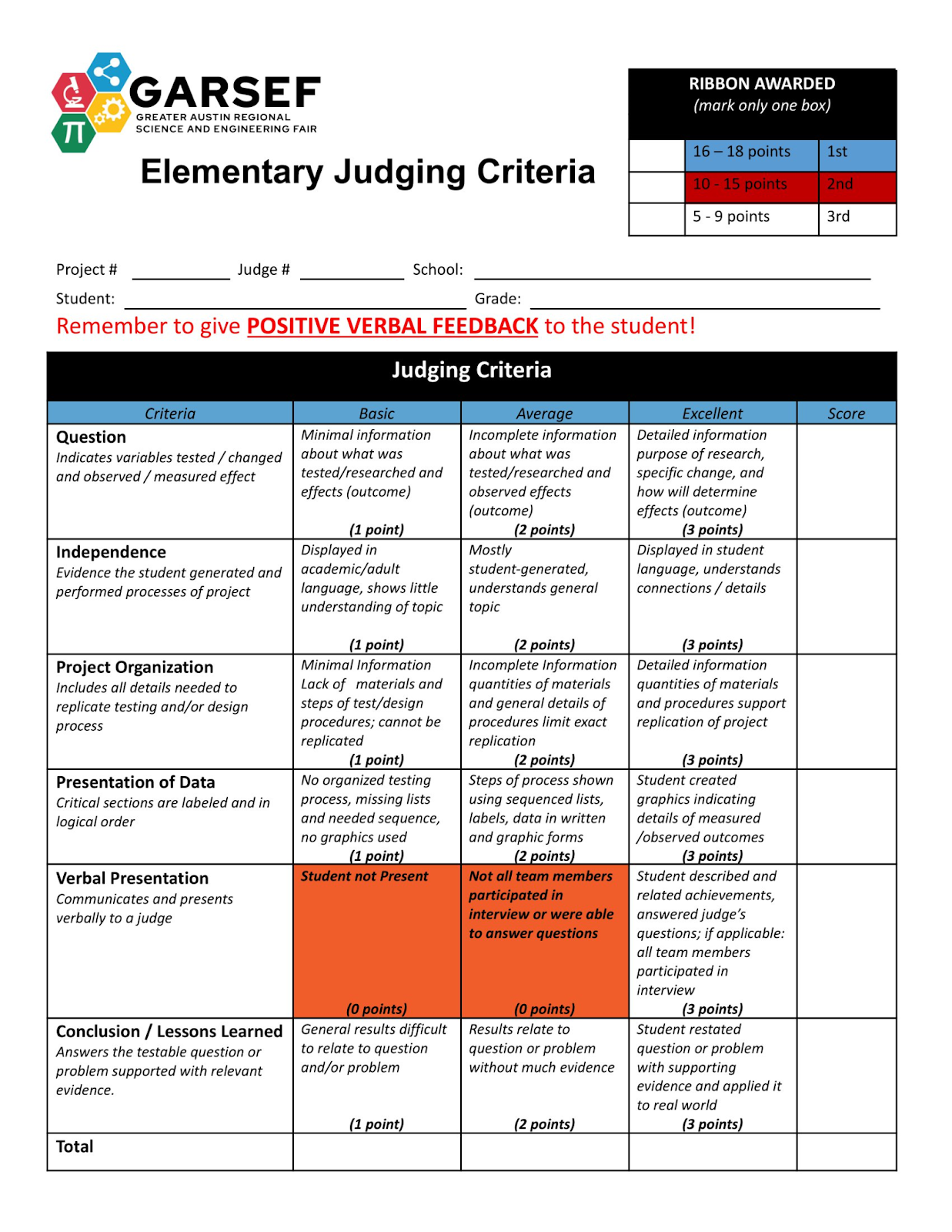- Mina Elementary
- Science Resources
- Science Fair
Dancer, Adrian
Page Navigation
-
Mina Elementary Science Fair Information 2023-2024
5th Grade Students
Participation:
-
All 5th grade students are required to complete a project. Students can complete the project as an individual, in pairs, or in a group of three. This will be done at school and will count as a daily grade in science.
-
Any student in grades K-5th can CHOOSE to complete a project at home in addition to the require project referenced above, if desired. This will not be taken for a grade, but will be shared in class and on display at Science Night on Friday, December 15th at Mina Elementary School. These individual projects from home can be considered for the Austin Regional Science fair for grades 3-5.
-
ONLY 3rd, 4th, and 5th GRADE PROJECTS CAN QUALIFY FOR THE GREATER AUSTIN REGIONAL SCIENCE AND ENGINEERING FAIR.
Projects must be under the Experiments Category:
-
Experiments - a student asks an experimental question, forms and tests a hypothesis, and makes conclusions. Example: I tested batteries to see which brand lasts the longest in a flashlight. (Experiments required for 4th & 5th graders.)
- Exhibits (Research Projects) will not be allowed for 4th or 5th grade students
The Science Fair can be a great opportunity for parents and children to work together. However, remember that this is your child’s project and the more work they do themselves, the more they will learn!
Please make sure that your child follows the correct guidelines according to which type of project he or she is completing.

Reminders:
-
Science Fair topic forms must be signed and returned to the student's science teacher by Wed. November 1, 2023. The form is only needed for those choosing to complete an at-home science fair project
-
Projects are due to science teachers on Mon. November, 27, 2023
-
Label the back right side of your project board with student's name, grade, and science teacher.
-
Do not send any liquids or breakable objects to school.
Project Rules
Students may conduct a science project individually or in teams with up to three members. A project may be disqualified if rules are not followed. No Elementary Division student project can involve:
• Firearms, explosives or discharge air pressure canister devices (i.e. potato guns)
• Growing bacteria or mold of any type: NOT ALLOWED
• Causing pain, suffering, sickness or death of an animal
• Breaking Local/State/Federal Law
• Production of ANY amount of consumable alcohol
• Any activity or substance that presents a danger to the student, other people or the environment, including hazardous chemicals or radioactive materials
Display & Safety (Exhibit Hall Rules)
Project display should be on sturdy tri-fold board available at local craft and office supply stores. Written material, drawings and pictures should be securely attached to the display board with glue or tape. Do not use staples. They will poke out the back of the board. Projects will be displayed on tables that are 36 inches high. Size of display area may not exceed the following measurements: 16” deep, 48” wide, and 72” high. Due to space limitations, displays that exceed these measurements cannot be accepted. Electricity for your display will not be available but you can use household batteries with your project. The following will not be allowed into the science fair:
•No organic material, such as dirt, plants, animal parts, etc.
•No food, candy, fruit, vegetables, water or liquids
•No chemicals, crystals, etc.
•No sharp or dangerous objects
Judging Criteria
Mina 5th graders will present their science projects during class on Monday, 11/27th & Tuesday, 11/28th. An independent panel of judges will score each eligible project to determine which projects will be submitted to the Greater Austin Regional Science and Engineering Fair. The results will be announced and ribbons awarded (First place, Second Place, etc.) at the Mina Campus Science Night on Thursday, December 14, 2023.

For the Regional Science Fair: Each project will receive a 1st, 2nd, or 3rd Place Ribbon. The Elementary Fair is meant to encourage young students to become engaged in STEM; it is not competitive. Students do not advance from GARSEF to another fair. Please make sure parents understand that students do not go on to TXSEF. Score sheets will not be made available. Judges' decisions are final. If students are in a group project, ALL PARTICIPANTS MUST be able to attend the Austin Regional Science Fair, or their project will be disqualified.
Discouraged Items
-
Items for demonstrations are discouraged. This is not a demonstration fair. Judges want to hear what the student has learned. Photographs of the project will suffice.
-
Expensive, breakable or fragile items
Allowed Items
-
Photographs, drawings, stuffed animals/artificial plants or imitation (play) food should be used to depict the prohibited or discouraged items.
-
Students should take photographs of project steps as a visual explanation of their effort. Students must ask permission before photographing other individuals for the display board.
-
Be sure to properly credit/list all sources of graphics and photographers on the display board (“Photograph taken by . . .”) This includes images from websites.
-
Students may use a computer and printer for written parts of the project.
Experiment
In an experiment, you will test a question to which you do NOT already know the answer. To test your question, you must follow the steps of the scientific method. These steps must be clearly displayed on the project board. Use this checklist to help you. To receive all possible points, all areas on the criteria feedback form must be addressed.
DISPLAY BOARD ELEMENTS:
-
Title of the Project
-
Problem / Testable Question: What question are you trying to answer? (i.e. Which brand of battery lasts the longest?) The testable question includes the property or characteristic (variable) that is changed and what effect is observed or measured.
-
Hypothesis: What do you THINK will happen? (Write this BEFORE you do the experiment.)
-
Variables: What variable was changed in your experiment? (Independent Variable = The one variable you purposely changed and tested) What variable was measured in your experiment? (Dependent Variable = The one variable you measured or observed) What variable stayed the same in your experiment? (Controlled Variable = The one variable you purposely did not change)
-
Background Information: What do books, articles, or the Internet say about your topic? (This should be about ½ page of information.) Explain the meaning of any scientific words that you may use in your experiment.
-
Experimental Materials: What items do you need to do the project? Be specific on quantity and items.
-
Experimental Procedure: These are the steps you follow to do the project. Write out all steps followed to prepare and run testing. Number each step in the order completed.
-
Results: What happened? Record test results using diagrams, photos, text, etc. Represent data evidence in table/chart form. Make a graph. Include a brief written description. The type of results displayed will depend on your individual project. You are not required to include all the types of evidence shown here, but make sure your judges will be able to understand what your results were from your presentation board.
-
Conclusion: Answer the project question and use evidence to support your claim or answer. Explain how evidence did or did not support the hypothesis. Tell how these findings apply to things in the “real world”.
-
References and Acknowledgements: Cite at least 3 sources for your background information on your project. These could be websites, articles, people interviewed, books, etc. or specific websites. Include title, author, publisher, and/or date retrieved from the web. Do not use “Google” or “Wikipedia” as an actual source.
-
Photo and Display Credits: Identify the person(s) who took your photos (including yourself). Clearly credit the source of any images, diagrams, drawings not created directly by you that were used in your project including websites.
EXAMPLES:
Do plants prefer to be watered with water, milk, or soda? Which brand of battery lasts the longest? Does warm water freeze faster than cold water? Which type of cup keeps water cold the longest?
Looking for project ideas? Click HERE!
ELEMENTARY PROJECT BOARD TEMPLATE AND EXAMPLE
What makes a good science fair project?
-
-
Benefits of Science Fair Projects
Time Commitment for a Science Fair Project
Scientific Method Simplified
The Science Fair Project - Experimental Process
1. Ask a TESTABLE Question aka a Measurable Question
2. Start a Journal where you will keep track of all of your Project information/data
3. Form a Hypothesis
4. Write the experiment Procedures (Steps)
5. Conduct your Experiment
6. Collect & Analyze Data. How will you display this information on your finished project poster? Be sure to keep track on any reference materials or resources you used!
7. Form a Conclusion. Was your initial hypothesis correct?
8. Create a Display & practice your presentation

